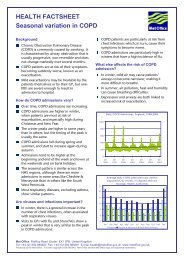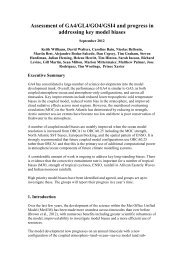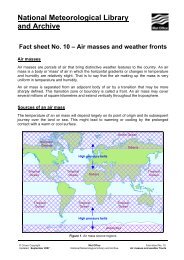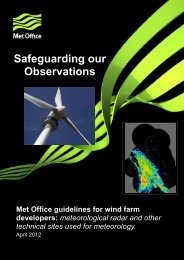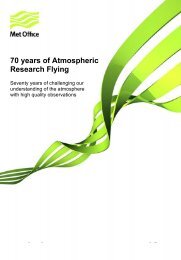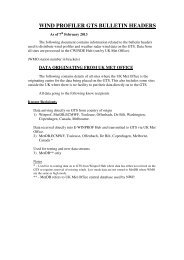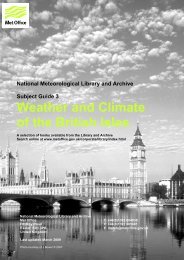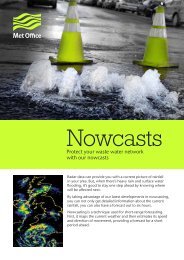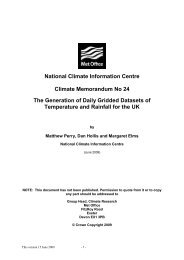Description and assessment of the OSTIA reanalysis. - Met Office
Description and assessment of the OSTIA reanalysis. - Met Office
Description and assessment of the OSTIA reanalysis. - Met Office
You also want an ePaper? Increase the reach of your titles
YUMPU automatically turns print PDFs into web optimized ePapers that Google loves.
Table 2.2: Input data differences between <strong>the</strong> <strong>reanalysis</strong> <strong>and</strong> operational <strong>OSTIA</strong> systems (see glossary<br />
for acronyms)<br />
Reanalysis<br />
Operational<br />
ATSR-1, ATSR-2,<br />
sampled)<br />
AATSR (not sub-<br />
AATSR (subsampled)<br />
AVHRR Pathfinder (not subsampled)<br />
NOAA-18 AVHRR,<br />
(subsampled)<br />
<strong>Met</strong>Op AVHRR<br />
No o<strong>the</strong>r satellite data types<br />
ICOADS in situ, nighttime only<br />
OSI-SAF reprocessed ice concentration<br />
(SMMR <strong>and</strong> SSM/I)<br />
SEVIRI, NAR, TMI, AMSR-E (subsampled)<br />
In situ via GTS, 24 hrs<br />
OSI-SAF operational ice concentration<br />
(SSM/I)<br />
in <strong>the</strong> higher latitudes than for <strong>the</strong> satellite data, although coverage close to <strong>the</strong> ice edge is poorer<br />
(figure 2.3).<br />
Figures 2.3(c) <strong>and</strong> 2.3(d) provide a comparison <strong>of</strong> <strong>the</strong> total number <strong>of</strong> observations for each grid<br />
box for two different years: one year from before <strong>the</strong> introduction <strong>of</strong> ATSR series data to <strong>the</strong> <strong>reanalysis</strong><br />
(1990) <strong>and</strong> one afterwards (2004). The ATSR series data increases <strong>the</strong> number <strong>of</strong> observations<br />
globally, but particularly in <strong>the</strong> equatorial regions <strong>and</strong> mid-latitudes. The number <strong>of</strong> observations at<br />
higher latitudes is also increased, see for example <strong>the</strong> north Atlantic Ocean <strong>and</strong> Sou<strong>the</strong>rn Ocean.<br />
Figures 2.3(e) <strong>and</strong> 2.3(f) show <strong>the</strong> total number <strong>of</strong> in situ observations for 1985 <strong>and</strong> 2007 respectively.<br />
These figures illustrate <strong>the</strong> improved global coverage <strong>of</strong> in situ observations at <strong>the</strong> end<br />
<strong>of</strong> <strong>the</strong> <strong>reanalysis</strong> period compared to <strong>the</strong> start, when <strong>the</strong> number <strong>of</strong> observations in <strong>the</strong> nor<strong>the</strong>rn<br />
hemisphere was significantly greater than in <strong>the</strong> sou<strong>the</strong>rn hemisphere. It is interesting to note <strong>the</strong><br />
change in <strong>the</strong> pattern <strong>of</strong> observations, from <strong>the</strong> straight lines characteristic <strong>of</strong> ship tracks in 1985<br />
(figure 2.3(e)) to <strong>the</strong> curved lines <strong>of</strong> drifters following current structures in 2007 (figure 2.3(f)). It is<br />
also notable that in 2007 <strong>the</strong> number <strong>of</strong> in situ observations in <strong>the</strong> Atlantic Ocean is greater than in<br />
<strong>the</strong> Pacific Ocean (figure 2.3(f)). There is also a relatively large number <strong>of</strong> in situ observations in<br />
2007 around <strong>the</strong> Antarctic Peninsula <strong>and</strong> in <strong>the</strong> Arctic north <strong>of</strong> Sc<strong>and</strong>inavia (figure 2.3(f)), presumably<br />
related to IPY (International Polar Year) activities at this time.<br />
Figure 2.4 shows <strong>the</strong> total number <strong>of</strong> observations for each 1/4 o grid box by season for <strong>the</strong><br />
entire <strong>reanalysis</strong> period (1985-2007). There is a marked seasonal difference in <strong>the</strong> number <strong>of</strong><br />
observations in <strong>the</strong> polar regions as all observations under ice are masked out (section 2.2) <strong>and</strong> <strong>the</strong><br />
ice extent varies seasonally. The sou<strong>the</strong>rn hemisphere region <strong>of</strong> multi-year ice in <strong>the</strong> Weddell Sea<br />
can be seen in <strong>the</strong> sou<strong>the</strong>rn hemisphere summer <strong>and</strong> autumn (December-February <strong>and</strong> March<br />
© c Crown Copyright 2011 11




